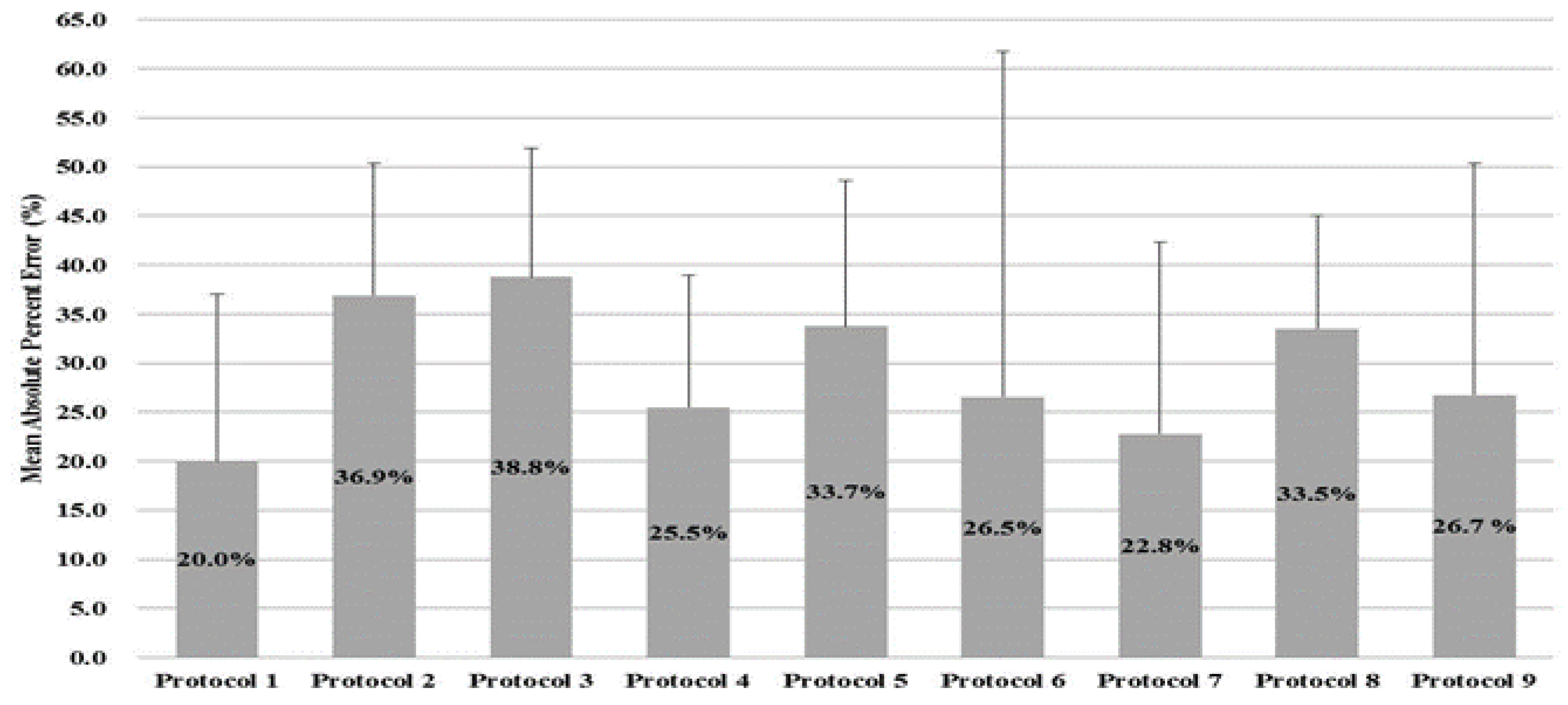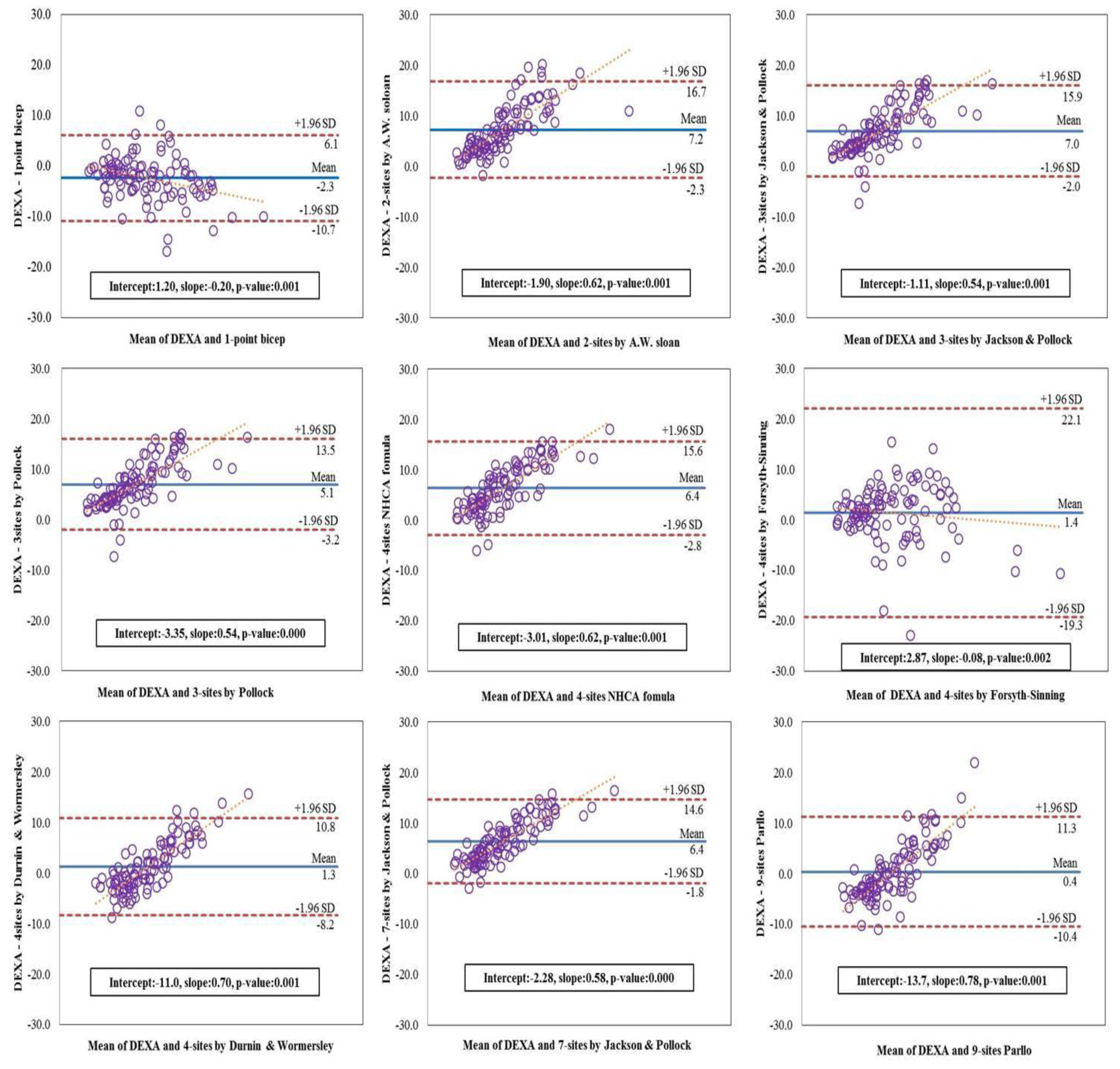Validity of the Portable Ultrasound BodyMetrix™ BX-2000 for Measuring Body Fat Percentage
Abstract
:1. Introduction
2. Materials and Methods
2.1. Participants
2.2. Anthropometric and Body Composition
2.3. BodyMetrix™ BX2000
2.4. Data Analysis
3. Results
4. Discussion
5. Conclusions
Author Contributions
Funding
Acknowledgments
Conflicts of Interest
References
- World Health Organization. Obesity and Overweight; World Health Organization: Geneva, Switzerland, 2017. [Google Scholar]
- Lee, A.; Cardel, M.; Donahoo, W.T. Social and Environmental Factors Influencing Obesity. In Endotext [Internet]; MDText. com, Inc.: South Dartmouth, MA, USA, 2019. [Google Scholar]
- Valle, M.; Gascón, F.; Martos, R.; Ruz, F.J.; Bermudo, F.; Morales, R.; Cañete, R. Metabolic cardiovascular syndrome in obese prepubertal children: The role of high fasting insulin levels. Metab. Clin. Exp. 2002, 51, 423–428. [Google Scholar] [CrossRef] [PubMed]
- Kumari, M.; Kozyrskyj, A.L. Gut microbial metabolism defines host metabolism: An emerging perspective in obesity and allergic inflammation. Obes. Rev. Off. J. Int. Assoc. Study Obes. 2017, 18, 18–31. [Google Scholar] [CrossRef] [PubMed]
- Thiebaud, R.S.; Abe, T.; Loenneke, J.P.; Fujita, E.; Akamine, T. Body fat percentage assessment by ultrasound subcutaneous fat thickness measurements in middle-aged and older adults. Clin. Nutr. 2019, 38, 2659–2667. [Google Scholar] [CrossRef] [PubMed]
- Hoffman, D.J.; Policastro, P.; Quick, V.; Lee, S.-K. Changes in body weight and fat mass of men and women in the first year of college: A study of the “freshman 15”. J. Am. Coll. Health 2006, 55, 41–46. [Google Scholar] [CrossRef] [PubMed]
- Gropper, S.S.; Simmons, K.P.; Connell, L.J.; Ulrich, P.V. Changes in body weight, composition, and shape: A 4-year study of college students. Appl. Physiol. Nutr. Metab. Physiol. Appl. Nutr. Metab. 2012, 37, 1118–1123. [Google Scholar] [CrossRef] [PubMed]
- Glaner, M.F.; Lima, W.A.; Borysiuk, Z. Body fat deposition and risk factors of cardiovascular diseases in men. Hum. Mov. 2010, 11, 45–50. [Google Scholar]
- Gómez-Ambrosi, J.; Silva, C.; Galofré, J.C.; Escalada, J.; Santos, S.; Gil, M.J.; Valentí, V.; Rotellar, F.; Ramírez, B.; Salvador, J. Body adiposity and type 2 diabetes: Increased risk with a high body fat percentage even having a normal BMI. Obesity 2011, 19, 1439–1444. [Google Scholar] [CrossRef] [PubMed]
- Loenneke, J.P.; Hirt, K.M.; Wilson, J.M.; Barnes, J.T.; Pujol, T.J. Predicting body composition in college students using the womersley and durnin body mass index equation. Asian J. Sports Med. 2013, 4, 153. [Google Scholar] [CrossRef] [PubMed] [Green Version]
- Morrow, J.R., Jr.; Mood, D.; Disch, J.; Kang, M. Measurement and Evaluation in Human Performance, 5E; Human Kinetics: Champaign, IL, USA, 2015. [Google Scholar]
- Smith-Ryan, A.E.; Blue, M.N.; Trexler, E.T.; Hirsch, K.R. Utility of ultrasound for body fat assessment: Validity and reliability compared to a multicompartment criterion. Clin. Physiol. Funct. Imaging 2018, 38, 220–226. [Google Scholar] [CrossRef] [PubMed]
- Lyon, J.; Drew, R.; MacRae, H. Comparison of skinfold thickness measures with ultrasound imaging to determine body composition. In Proceedings of the 26th Annual Meeting of the Southwest Chapter of the American College of Sports Medicine, San Diego, CA, USA, 10–11 November 2006. [Google Scholar]
- Ulbricht, L.; Neves, E.B.; Ripka, W.L.; Romaneli, E.F. Comparison between body fat measurements obtained by portable ultrasound and caliper in young adults. In Proceedings of the 2012 Annual International Conference of the IEEE Engineering in Medicine and Biology Society, San Diego, CA, USA, 28 August–1 September 2012; IEEE: San Diego, CA, USA, 2012; pp. 1952–1955. [Google Scholar]
- Kang, S.; Lee, M.; Kim, Y. Feasibility of Ultrasound Measuring Equipment by Body Fat Percentage Examination. J. Asian Soc. Health Exerc. 2019, 1, 19–29. [Google Scholar]
- Johnson, K.E.; Naccarato, I.A.; Corder, M.A.; Repovich, W.E. Validation of three body composition techniques with a comparison of ultrasound abdominal fat depths against an octopolar bioelectrical impedance device. Int. J. Exerc. Sci. 2012, 5, 205. [Google Scholar] [PubMed]
- Loenneke, J.P.; Barnes, J.T.; Wagganer, J.D.; Wilson, J.M.; Lowery, R.P.; Green, C.E.; Pujol, T.J. Validity and reliability of an ultrasound system for estimating adipose tissue. Clin. Physiol. Funct. Imaging 2014, 34, 159–162. [Google Scholar] [CrossRef] [PubMed]
- Hauck, W.W.; Anderson, S. A new statistical procedure for testing equivalence in two-group comparative bioavailability trials. J. Pharmacokinet. Biopharm. 1984, 12, 83–91. [Google Scholar] [CrossRef] [PubMed]
- Johnson, K.E.; Miller, B.; Juvancic-Heltzel, J.A.; Agnor, S.E.; Kiger, D.L.; Kappler, R.M.; Otterstetter, R. Agreement between ultrasound and dual-energy X-ray absorptiometry in assessing percentage body fat in college-aged adults. Clin. Physiol. Funct. Imaging 2014, 34, 493–496. [Google Scholar] [CrossRef] [PubMed]
- Pineau, J.-C.; Filliard, J.R.; Bocquet, M. Ultrasound techniques applied to body fat measurement in male and female athletes. J. Athl. Train. 2009, 44, 142–147. [Google Scholar] [CrossRef] [PubMed] [Green Version]
- Staudenmayer, J.; Zhu, W.; Catellier, D.J. Statistical considerations in the analysis of accelerometry-based activity monitor data. Med. Sci. Sports Exerc. 2012, 44, S61–S67. [Google Scholar] [CrossRef] [PubMed]
- Hopkins, W.; Marshall, S.; Batterham, A.; Hanin, J. Progressive statistics for studies in sports medicine and exercise science. Med. Sci. Sports Exerc. 2009, 41, 3. [Google Scholar] [CrossRef] [PubMed] [Green Version]
- Dixon, P.M.; Saint-Maurice, P.F.; Kim, Y.; Hibbing, P.; Bai, Y.; Welk, G.J. A primer on the use of equivalence testing for evaluating measurement agreement. Med. Sci. Sports Exerc. 2018, 50, 837. [Google Scholar] [CrossRef] [PubMed] [Green Version]



| BodyMetrix™ BX-2000 | ||
|---|---|---|
| No. | Protocols | Measuring Sites |
| 1 | 1-point Bicep | Bicep |
| 2 | 2-sites by A. W. Sloan | Thigh, Scapula |
| 3 | 3-sites by Jackson & Pollock | Thigh, Chest, Waist |
| 4 | 3-sites by Pollock | Chest, Scapula, Tricep |
| 5 | 4-sites NHCA Formula | Chest, Scapula, Axilla, Waist |
| 6 | 4-sites by Forsyth-Sinning | Waist, Tricep, Scapula, Axilla |
| 7 | 4-sites by Durnin & Wormersley | Bicep, Scapula, Tricep, Hip |
| 8 | 7-sites by Jackson & Pollock | Chest, Scapula, Axilla, Tricep, Waist, Hip, Thigh |
| 9 | 9-site Parllo | Chest, Tricep, Bicep, Scapula, Lower Back, Hip, Waist, Thigh, Calf |
| Variables | Males (n = 105) | ||
|---|---|---|---|
| Mean ± SD | Minimum | Maximum | |
| Age (year) | 20.01 ± 2.11 | 18.0 | 25.0 |
| Height (cm) | 174.81 ± 6.01 | 163.0 | 193.0 |
| Weight (kg) | 73.26 ± 13.60 | 58.0 | 150.0 |
| BMI (kg·m−2) | 23.91 ± 3.77 | 18.4 | 47.3 |
| Variables | Mean ± SD | DEXA | P 1 | P 2 | P 3 | P 4 | P 5 | P 6 | P 7 | P 8 | P 9 |
|---|---|---|---|---|---|---|---|---|---|---|---|
| DEXA | 18.22 ± 8.04 | 1 | |||||||||
| P 1 | 15.90 ± 6.64 | 0.843 ** | 1 | ||||||||
| P 2 | 10.98 ± 4.41 | 0.851 ** | 0.755 ** | 1 | |||||||
| P 3 | 11.23 ± 4.74 | 0.866 ** | 0.772 ** | 0.863 ** | 1 | ||||||
| P 4 | 13.07 ± 4.73 | 0.901 ** | 0.843 ** | 0.865 ** | 0.870 ** | 1 | |||||
| P 5 | 11.86 ± 4.39 | 0.873 ** | 0.788 ** | 0.826 ** | 0.953 ** | 0.898 ** | 1 | ||||
| P 6 | 16.80 ± 8.65 | 0.770 ** | 0.693 ** | 0.837 ** | 0.946 ** | 0.814 ** | 0.903 ** | 1 | |||
| P 7 | 16.92 ± 4.04 | 0.877 ** | 0.826 ** | 0.834 ** | 0.814 ** | 0.916 ** | 0.822 ** | 0.781 ** | 1 | ||
| P 8 | 11.79 ± 4.52 | 0.926 ** | 0.825 ** | 0.885 ** | 0.954 ** | 0.937 ** | 0.965 ** | 0.900 ** | 0.927 ** | 1 | |
| P 9 | 17.77 ± 3.80 | 0.790 ** | 0.737 ** | 0.725 ** | 0.803 ** | 0.844 ** | 0.772 ** | 0.749 ** | 0.842 ** | 0.837 ** | 1 |
Publisher’s Note: MDPI stays neutral with regard to jurisdictional claims in published maps and institutional affiliations. |
© 2020 by the authors. Licensee MDPI, Basel, Switzerland. This article is an open access article distributed under the terms and conditions of the Creative Commons Attribution (CC BY) license (http://creativecommons.org/licenses/by/4.0/).
Share and Cite
Kang, S.; Park, J.-H.; Seo, M.-W.; Jung, H.C.; Kim, Y.I.; Lee, J.-M. Validity of the Portable Ultrasound BodyMetrix™ BX-2000 for Measuring Body Fat Percentage. Sustainability 2020, 12, 8786. https://doi.org/10.3390/su12218786
Kang S, Park J-H, Seo M-W, Jung HC, Kim YI, Lee J-M. Validity of the Portable Ultrasound BodyMetrix™ BX-2000 for Measuring Body Fat Percentage. Sustainability. 2020; 12(21):8786. https://doi.org/10.3390/su12218786
Chicago/Turabian StyleKang, Seoungki, Jeong-Hui Park, Myong-Won Seo, Hyun Chul Jung, Yong Ik Kim, and Jung-Min Lee. 2020. "Validity of the Portable Ultrasound BodyMetrix™ BX-2000 for Measuring Body Fat Percentage" Sustainability 12, no. 21: 8786. https://doi.org/10.3390/su12218786
APA StyleKang, S., Park, J.-H., Seo, M.-W., Jung, H. C., Kim, Y. I., & Lee, J.-M. (2020). Validity of the Portable Ultrasound BodyMetrix™ BX-2000 for Measuring Body Fat Percentage. Sustainability, 12(21), 8786. https://doi.org/10.3390/su12218786








